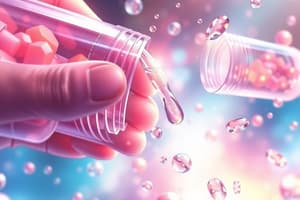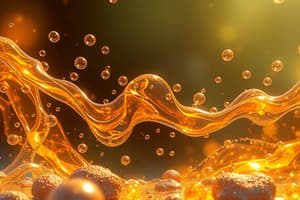Podcast
Questions and Answers
What is the primary purpose of evaluating stability for a solution?
What is the primary purpose of evaluating stability for a solution?
- To verify the viscosity of the solution
- To assess chemical, physical, and microbial stability over its shelf life (correct)
- To determine the solution's flavor profile
- To classify the solution according to its route of administration
Which pH range is typically tolerable for oral solutions?
Which pH range is typically tolerable for oral solutions?
- 5–10
- 7–14
- 0–2
- 2–9 (correct)
For which purpose would you use gingival solutions?
For which purpose would you use gingival solutions?
- To administer systemic medication
- To perform a dental rinse
- To enhance skin absorption of drugs
- To treat local infection and inflammation in the oral cavity (correct)
What is a defining characteristic of a lotion in topical solutions?
What is a defining characteristic of a lotion in topical solutions?
Which of the following is a concentrated solution used for antimicrobial purposes?
Which of the following is a concentrated solution used for antimicrobial purposes?
What is the role of flavoring, coloring, and sweetening agents in oral solutions?
What is the role of flavoring, coloring, and sweetening agents in oral solutions?
What type of solution is typically used to apply a polymeric film on the skin?
What type of solution is typically used to apply a polymeric film on the skin?
What aspect of viscosity is critical for oral solutions?
What aspect of viscosity is critical for oral solutions?
What is a key characteristic of nail solutions when applied?
What is a key characteristic of nail solutions when applied?
What type of solutions are primarily used for ear wax removal?
What type of solutions are primarily used for ear wax removal?
What is the typical pH range for nasal solutions?
What is the typical pH range for nasal solutions?
Which of the following is a requirement for pulmonary inhaled solutions used in nebulizers?
Which of the following is a requirement for pulmonary inhaled solutions used in nebulizers?
Which solution type may use flavouring or sweetening agents?
Which solution type may use flavouring or sweetening agents?
What is the volume range for micro-enemas?
What is the volume range for micro-enemas?
Which type of solutions doesn't need to be isotonic as they are for external use?
Which type of solutions doesn't need to be isotonic as they are for external use?
What is a defining characteristic of macro-enemas?
What is a defining characteristic of macro-enemas?
Which step in the preparation of solutions ensures that the active ingredient is uniformly distributed?
Which step in the preparation of solutions ensures that the active ingredient is uniformly distributed?
What factor does NOT typically influence the solubility of a drug in water?
What factor does NOT typically influence the solubility of a drug in water?
Which of the following techniques is used to ensure the clarity and stability of a solution?
Which of the following techniques is used to ensure the clarity and stability of a solution?
Which method can enhance drug solubility through structural alteration in aqueous solutions?
Which method can enhance drug solubility through structural alteration in aqueous solutions?
In the context of oral and topical liquid dosage forms, which statement is most accurate?
In the context of oral and topical liquid dosage forms, which statement is most accurate?
Which of the following is a common feature of weak acids or weak bases in solution?
Which of the following is a common feature of weak acids or weak bases in solution?
Why is packaging an important step in the preparation of pharmaceutical solutions?
Why is packaging an important step in the preparation of pharmaceutical solutions?
What is one purpose of pH adjustment in the preparation of solutions?
What is one purpose of pH adjustment in the preparation of solutions?
Flashcards
Stability
Stability
Evaluates how well a solution stays chemically, physically, and microbially stable throughout its intended shelf life.
Oral Solutions
Oral Solutions
Liquid medications taken by mouth, intended for systemic or local effects in the gastrointestinal tract.
Oral Cavity Solutions
Oral Cavity Solutions
Aqueous formulations designed for direct application to the oral cavity, used for local effects like treating infections and inflammation.
Topical Solutions
Topical Solutions
Signup and view all the flashcards
Lotion
Lotion
Signup and view all the flashcards
Liniment
Liniment
Signup and view all the flashcards
Paints and Tinctures
Paints and Tinctures
Signup and view all the flashcards
Collodion
Collodion
Signup and view all the flashcards
Nail Solutions
Nail Solutions
Signup and view all the flashcards
指甲溶液
指甲溶液
Signup and view all the flashcards
Otic Solutions
Otic Solutions
Signup and view all the flashcards
Nasal Solutions
Nasal Solutions
Signup and view all the flashcards
Pulmonary Inhaled Solutions
Pulmonary Inhaled Solutions
Signup and view all the flashcards
Rectal Solutions (Enemas)
Rectal Solutions (Enemas)
Signup and view all the flashcards
Viscous Otic Solutions
Viscous Otic Solutions
Signup and view all the flashcards
Nasal Solution pH
Nasal Solution pH
Signup and view all the flashcards
Dissolution
Dissolution
Signup and view all the flashcards
Mixing
Mixing
Signup and view all the flashcards
Filtration
Filtration
Signup and view all the flashcards
Packaging
Packaging
Signup and view all the flashcards
Enhancement of Drug Solubility
Enhancement of Drug Solubility
Signup and view all the flashcards
pH Adjustment
pH Adjustment
Signup and view all the flashcards
Co-solvents
Co-solvents
Signup and view all the flashcards
Micelles & Surfactants
Micelles & Surfactants
Signup and view all the flashcards
Study Notes
Pharmaceutical Solutions (Lecture 2)
- Intended learning outcomes include describing solution preparation, differentiating methods for enhancing drug solubility, detailing solution stability aspects and possible incompatibilities, and defining various oral and topical liquid dosage forms.
- Solution preparation involves weighing, dissolving, adjusting pH, adjusting volume, and labeling/storing.
- Techniques for preparing solutions include dissolution, mixing, filtration, and packaging.
- Factors affecting drug solubility include molecular structure, crystal structure, particle size, pKa, and pH of the medium (drug as weak acid/base or salt).
- Methods for enhancing drug solubility include co-solvents, pH adjustment, cyclodextrins, and surfactants/micelles.
- pH adjustment is a common technique to increase drug solubility by either increasing ionization of weak acids or decreasing ionization of weak bases.
- Buffer solutions (e.g., citrate, acetate, phosphate, carbonate) are used to adjust pH.
- The chosen pH should not negatively affect drug or excipient stability.
- Cyclodextrins (CDs) are non-reducing cyclic glucose oligosaccharides, comprising variable numbers of glucose residues. Alpha, beta, and gamma CDs consist of 6, 7, and 8 d-glucopyranosyl units, respectively, and are visualized as a hollow truncated cone.
- The cavity of cyclodextrins is hydrophobic, while the exterior is hydrophilic, enabling non-polar drugs to be embedded and dispersed in water.
- Solution stability involves maintaining physical, chemical, microbiological, therapeutic, and toxicological properties from manufacturing to use.
- Factors affecting physical stability include sorption of drug to containers, extraction of materials into liquid, shedding of particles, drug precipitation or degradation.
- Factors affecting chemical stability include temperature, light, humidity, oxygen, solvent composition, ionic strength, pH, and excipient compatibility; hydrolysis, oxidation, decarboxylation, epimerization, and polymerization are examples of chemical reactions.
- Incompatibilities can arise from excipient degradation (interaction with other excipients or drugs) or from interactions between preservatives (p-hydroxybenzoate) and other components (sorbitol). Drug degradation is also a type of incompatibility.
- Sodium metabisulphite, used as an antioxidant in epinephrine (adrenaline) injections, can react with epinephrine for significant degradation.
- Microbial stability is crucial for sterile products and solutions for injection/use or in multidose solutions; use of preservatives is critical to avoid growth.
- Quality control includes assessing appearance (clarity, no particulates), pH, assay (drug concentration), sterility, and stability (over shelf-life).
- Solutions can be classified by administration route: oral, oral cavity, topical, otic, nasal, pulmonary, rectal, vaginal, ocular, and parenteral.
- Regulatory framework for liquid dosage form solutions considers FDA, EMA, guidelines, and manufacturing, packaging, labeling requirements.
- Pharmacopoeial standards offer quality, purity, and performance of solution dosage forms.
- Good Manufacturing Practices (GMP) ensure production quality, consistency, and safety, covering facilities, equipment, personnel, and documentation.
Studying That Suits You
Use AI to generate personalized quizzes and flashcards to suit your learning preferences.




